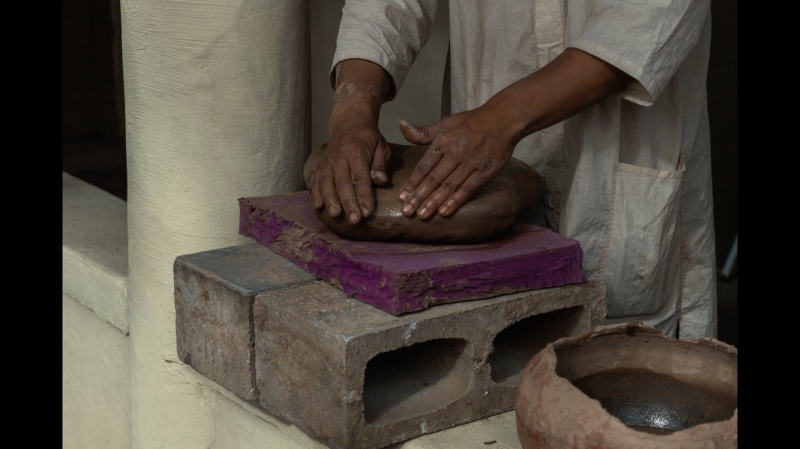Before the Last Rubble, In the Face of Dawn (2038)
Pastizal Zamudio is an artist who works between their hometown, Mexicali B.C., and the natural landscapes, rural contexts, and different agricultural fields of the United States. Their nomadic condition has led them to be interested in the choreographic possibilities of the body. Based on labor, ritual, and social processes, the artist carries out actions of prolonged observation, long walks, and exhausting journeys of physical resistance under the sun. During these experiences, Zamudio builds extensive load-bearing prostheses, assembles talismans and organic fetishes, and captures images of microscopic entities.
Zamudio’s first house as a child was El Sitio, the builder’s yard that was part of the experimental housing complex built by renowned architect Christopher Alexander and his colleagues in Mexicali between 1975 and 1976 (today the UNICOM facility, a health clinic and community center of the UABC).1 In early 2022, INSITE commissioned Zamudio to create an art project, including a work that could be based on their experience and memory of El Sitio. Through the university, the artist had access to their first home for a year to carry out their research. From a number of visits to the place, Alexander’s books as reference, and trips to California to see other houses built by the architect, Zamudio conceived the work Before the Last Rubble, In the Face of Dawn (2038), a permanent installation on the central courtyard of El Sitio, made with more than 100 clay tiles crafted with soil extracted from the surrounding area. Through a collaboration with UABC, UNICOM, architects, artists, ceramists, builders, and neighbors, the project began to take shape in early 2023.
The work takes as its starting point the physical and conceptual notion of the ground, an element that appears throughout Alexander’s work, and which has also been of interest to the artist in their choreographic displacements. In the book The Production of Houses (1985), Alexander details the construction process of El Sitio step by step, including the experiments that were carried out to make the blocks with materials found in the area and the importance of laying the tiles irregularly in the ground so that “spontaneous gardens” can grow between the cracks. The architect specifies that a house is an organic system and a living being, where everything must be assembled down to the last detail, and describes the interior patio of El Sitio as the “physical and spiritual starting point” of the entire project.
During their research, Zamudio noticed that this central patio had recently been renovated with cement and, following Alexander’s reasoning, they proposed a way to return to the architect’s principles by substituting this concrete with handmade organic tiles. The design of the new floor was conceived after Zamudio found coincidences between patterns and elements in Alexander’s designs, and their own cosmological figures, specifically the irregular sun-star shape that has appeared throughout their work. To start the project, Zamudio followed the architect’s way of building, first working intuitively directly on site without formal plans, and then extracting earth from the neighboring area to prepare the clay for the tiles. As if it were a sculpture, each paving stone was individually crafted by the artist and will be placed leaving spaces between the cracks, as Alexander proposed, so that different species of microscopic plants can grow between them as spontaneous gardens.
As each of the organic tiles transforms over time, whether eroded by the sun, the growth of nature, or by people walking, the new floor is expected to function as a restorative, therapeutic, and spiritual space for the community that is part of UNICOM.
[1]UNICOM is part of the Faculty of Nursing at the Universidad Autónoma de Baja California (Autonomous University of Baja California).
Collaborators
Vi Miranda
Hugo Fermé
Victor Manuel Antonio Roblero
Marcela Guevara
Porfirio Aceves Palacio
Power
Jonathan Rivera
Juliana Camacho
Liz Stringer
Institutions
Universidad Autónoma de Baja California
Coordinación General de Extensión de la Cultura y Divulgación de la Ciencia de la UABC
Centro Comunitario UNICOM, Facultad de Enfermería de la UABC
Facultad de Arquitectura de la UABC

